How to Pack Light for Independent Travel
Essential Checklists
and Tips for the Voyager
Article and photos by Ted
Campbell
Published 8/1/2015. Updated 5/8/2024.

|
|
Pack as light as possible for
your independent travel. You won't regret it.
|
She stumbled into the hostel dorm room,
a small and pretty blonde woman. The huge backpack towered
over her head. Hiking boots and plastic bags dangled behind.
A big camera bag hung around her neck, bouncing against
a smaller backpack strapped across her chest, stuffed-full,
and nearly bursting.
We smiled, introduced ourselves, and
chatted as she struggled with her gear. She unpacked. Bunches
of wrinkled clothes came out first, all pinks and purples.
Then a bulky sleeping bag.
“Do you not trust the hostel sheets?”
I asked.
“No, I’ll be camping when I get to Vietnam.”
Then she pulled out a big winter coat,
blaze orange and puffy. Next was a grey winter hat with
gloves stuffed inside.
“And all that?”
“Oh, that’s for when I get to Switzerland.
It’ll be winter and I want to go skiing.”
I shrugged and wiped the sweat from
my forehead. We were in hot Rio Dulce, Guatemala,
at the edge of the even-hotter Peten jungle.
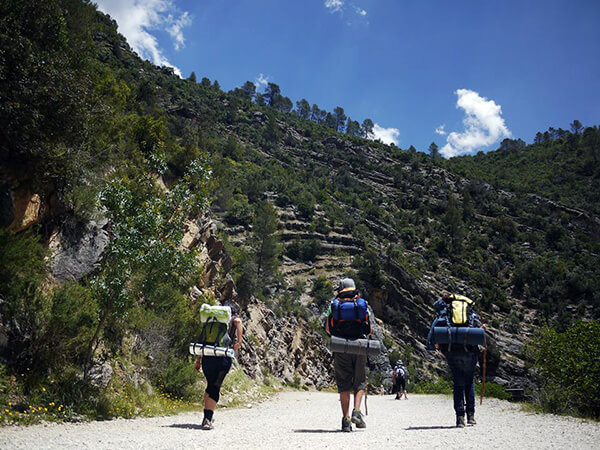
|
|
You want to especially travel
light when hiking in hot dry climates.
|
Packing: What Not to Bring Abroad
I made the same mistake on my trip to
Europe, but even worse. I brought a big external frame backpack
I used for backcountry camping, with my tent and sleeping
bag inside. It was huge and awkward. I felt like a doofus
carrying it around cities and train stations.
Packing light is important for many
reasons, but most of all to remain mobile and to stay safe.
You can carry a mid-sized backpack over long distances without
getting sore, and you can stuff it under your legs on a
bus trip, preventing worries about theft or a good soaking
from rain.
The best way to ensure light packing
is to limit your travels to one region, rather than opting
for a round-world trip. I prefer going to one place at a
time anyway. The more time you spend at any destination,
the more you will really get to know it. You have a whole
lifetime ahead of you to venture to other parts of the world.
If you insist on traveling the whole
world on one trip — and around the world travel is seductive
or fitting for some — then buy stuff on the way. The 1-time
expense of a winter jacket will be offset by the convenience
of not dragging it around with you for six months in hot
climates. And when you don’t need it anymore, ship it to
yourself back home or give it away. Most people who travel
eventually rely on some form of karma.
For example, if it never rains in your
part of the world, then the raincoat you buy before your
trip will probably be more expensive than if you wait until
arriving in, say, Vancouver, where it rains half the year
and hundreds of stores sell raincoats and umbrellas.
If you want to ski, rent your gear,
even winter clothes. If you want to scuba dive, rent your
wetsuit. Do a little research beforehand: Can you rent a
tent and sleeping bag for that week at a national park in
New Zealand?
A Packing Checklist: Clothing and
Essentials
-
Everyday clothes: Yes,
quick-dry adventure clothing is quite handy when you
are hiking, but don’t you feel embarrassed for the tourist
dressed as if he’s on safari while strolling down the
Champs-Elysees in Paris? Be sure to pack everyday clothes.
Although they are heavy and dry slowly, you’ll be grateful
for that pair of jeans when you want to blend in with
the locals.
I usually bring a pair of shorts,
two pairs of pants, one nice button-down shirt, and lots
of socks, underwear, and t-shirts — enough for
a week or two to rotate between trips to the laundry.
-
T-shirts: They
are cheap everywhere. If you really need to save money,
get a 4-pack at your favorite discount store at home
or at a street market abroad.
-
Sweater, hooded sweatshirt,
or fleece: It doesn’t matter how hot the
climate is, it might get cold at night. And on the
bus or at naptime, your sweater makes a great pillow.
I like lightweight, quick-dry fleeces, but something
simple and dark that I can wear on a night out in
the city.
-
Shoes: There was
a time I brought tennis shoes or hiking boots on every
trip, but now I look for a multi-purpose shoe: comfortable
for lots of walking, a stiff sole for hiking, and dark
colors for going out. If it’s rain resistant, even better,
but if not, I pack a pair of wool socks.
-
Toiletries: Well,
you obviously need to carry soap. Buy a small plastic
container for it. But do you need shaving cream and shampoo?
You might find that soap works fine.
-
Copies of passport and other
documents: Carry them in a hidden part of
your backpack. Take digital photos and keep copies
in your email account or on a flashcard.
-
A variety of debit cards: One
day in La Paz, Bolivia, I withdrew money, walked two
blocks from the ATM, and realized I
had left the card in the machine. I ran back and
it was gone. My backup had expired. So I spend two weeks
longer in La Paz than I had planned while I waited for
the replacement card, running up tabs in my hotel and
favorite bar.
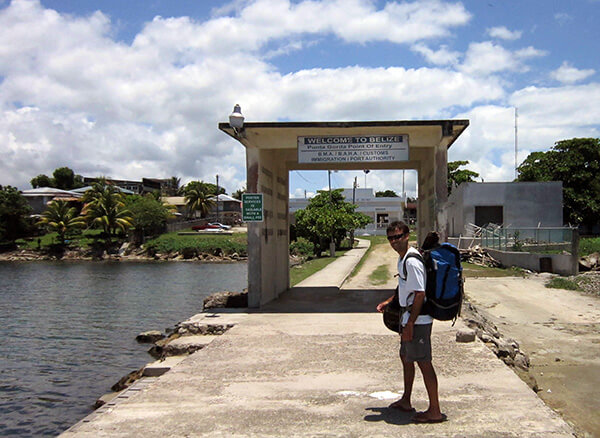
|
|
Packing light for a border crossing
into Belize.
|
Less Obvious Useful Items to Pack
Along with extra sunglasses, sunscreen,
and a money belt, I always bring a few small things on every
trip.
-
A scarf and earplugs: The
scarf makes for a great blindfold on public transportation,
a hostel dorm room, or a hotel room with weak curtains.
The earplugs are invaluable in the same places. Bring
extras, because they are easy to lose and get nasty quick,
and they can be hard to find in some countries. Look
for them in drugstores.
-
Headlamp: You will
love your headlamp on an overnight bus with no lights
when you are wide-awake and want to read. You will love
it when you have to wake up early and pack your things
in a dark hostel dorm room and you don’t want to wake
everyone up. Carry spare batteries. Batteries always
run out when you need them most.
-
Pen with duct tape: We
all know how useful duct tape is: for repairing torn
clothing, shoes or backpacks; for fixing the spine of
a book; and even as a band-aid substitute on blisters
and injuries. But who wants to schlep around a whole
roll? Roll some onto a pen or pencil.
-
Tiger balm: This
stuff cures mosquito bites. Trust me. But the trick is
that you can’t scratch. Apply the balm and endure the
itching for a minute, and the bite will go away.
-
Gold Bond Medicated Powder: Without
getting too graphic, let me tell you that walking around
in hot, humid places can be, well...chafing. Gold bond
is your friend. Also, use it when your shoes or feet
get funky.
-
A first-aid kit: You
can find small ones for camping, about half the size
of a paperback. Make sure it has band-aids and disinfectant
for wounds. Buy a small bottle of liquid band-aid, a
gel that forms in a cut and works great. However, don’t
worry too much about medicine because in many parts of
the world the medicine you find (like for diarrhea) can
be much stronger and cheaper.
-
A tiny, quick-dry towel: One
the size of a sheet of paper will do. As your dry yourself,
continually wring it out.
-
Flip-flops: Even
if you are skiing in Switzerland, bring plastic flip-flops
for the hotel shower or for when your shoes get wet.
I like Havainaias from Brazil.
-
Swimsuit: You never
know when you will need it. Even the cheapest hotel might
have a pool.
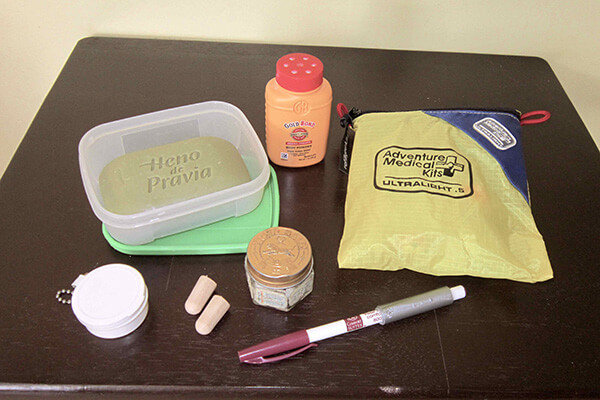
|
|
A few essentials you may want
to pack.
|
Fun Stuff and Indulgences
Then there’s the other packing extreme:
the person who drills holes in their toothbrush to save
weight. He invariably wants to borrow your shampoo, or your
laptop. Make sure you bring what you need, but also think
about what will make you enjoy your trip more.
-
Books: If you love
to read, bring a book, but bring something you don’t
mind trading once you finish it. Your friend’s beautiful
note on the inside cover will make a complete stranger
smile someday. Or, leave the book at home. But didn’t
your friend give it to you to read on the trip?
It’s easy to find a book exchange
in a hostel, restaurant, café or even a bookstore. I
bring two books so I can start the second right away
while I look for a good replacement for the other.
-
Language books: If
you want to learn the language of the place where you
are traveling, bring a textbook. I’m not a fan of traveler’s
phrasebooks, which don’t really teach you anything. Find
a book that actually teaches the language. Read the first
ten pages. Do the exercises. Do you understand? Do you
think you can learn from it?
Another tip: Don’t write in the book.
Do the exercises on scrap paper. Then when you finish
the book, you can pass it on or sell it.
-
Travel journal: It
doesn’t have to be leather-bound or made using special
paper. A one-dollar notebook will do. I like smaller
ones that I can fold in half and stick in my pocket.
The notebook is not only your journal,
but also a place to write down information, ideas, impressions,
memories, and suggestions. Other travelers are your best
source for travel tips, but you’ll never remember their
advice if you don’t write it down.
-
Camera: An expensive camera isn’t only a monetary investment, but an investment of space. If you carry a nice camera with a big lens, try to fit the whole case in your backpack so you don’t always have to carry it around loose, making it more susceptible to theft.
-
Smartphone: When I first wrote this article 10 years ago, I discussed the possibility of leaving your smartphone at home. Now, traveling without it is clearly out of the question. You’ll need it for making hotel reservations, downloading boarding passes, and numerous other essentials.
My original point stands, however. If you’re a smartphone addict, try to put it away at key moments. For example, I rode my bicycle up a dirt road to the crater of an extinct volcano, 15,000 feet high with sweeping views of the central Mexican altiplano (high central region). Half of the people passing in cars were looking at their phones instead of the scenery. Don’t be like those people.
-
Laptops, iPads: There are many good reasons to take your laptop or tablet with you, especially if you use it for work or to store photos that you want to back up right away. But, if whatever you need it for can be done on your smartphone, then save space and worry by leaving it at home.
If you do bring a laptop or tablet, don’t forget a waterproof bag. Heavy plastic bags from the duty-free shop work great.
-
HDMI cable: Use it to connect your smartphone, laptop or tablet to a hotel television, so you can enjoy customized entertainment. Make sure you get the right connection to your device, and do a test before you leave home. Also, be aware that the cable may not be necessary in the near future, when you'll be able to use Bluetooth (or an alternative) instead.
-
Musical Instruments: My big
indulgence is my guitar. It can be inconvenient
on a long distance bus — I have to set it between
my feet — but it is a great way to meet people. It
has no value other than sentimental, so I don’t worry
about it in the rain or in questionable hands. I bought
it for around five dollars at a guitar market in Bolivia
seven years ago. Now it’s full of stickers, scratches,
and sand.
However, I don't recommend bringing
a guitar if you are a beginner. People will request a
song, and when they realize that you can’t actually play,
someone else will pull the guitar out of your hands — not
necessarily a bad thing, but you’re the one who has to
lug it around.
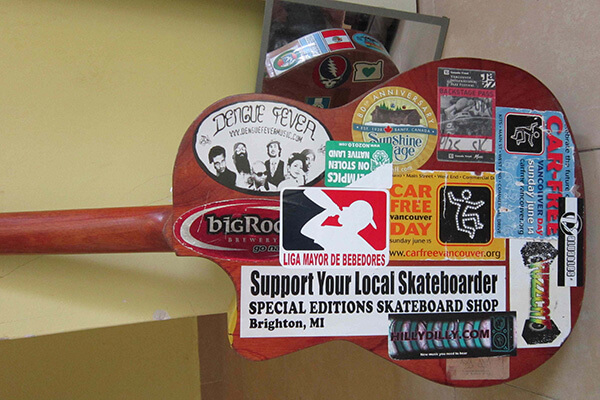
|
|
Traveling with an inexpensive
guitar is a fun indulgence for the author.
|
Yes, the road is a good time to learn
an instrument, but consider a harmonica, a small shaker,
or perhaps a ukulele.
I don’t recommend traveling with
a hand drum (djembe, bongo, etc.) if you can’t play it.
Not only will you annoy everyone around you, but the
drunks who take it from you and can’t play either will
drive you crazy as well.
Final Thoughts on Packing for your
Independent Travel
Don’t bring anything irreplaceable.
Leave your first edition Hemingway at home. Leave your grandfather’s
watch at home. Carry a cheap guitar.
Make backups of your photos and send
them back home on a USB stick, CD, or if you have a laptop
via backup to a cloud. When your camera is stolen (as mine
was once), you’ll find that you miss the photos much more
than the camera.
When packing, less is more. If in doubt,
leave it at home. You don’t ever want to meet someone like
me on the road with my small backpack and say, “I envy you.”
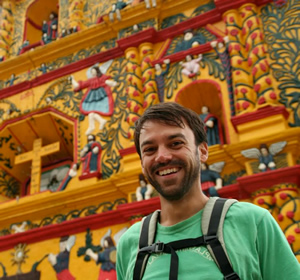
|
Ted Campbell is a freelance writer, Spanish-English translator, and university teacher living in Mexico.
He has written two guidebooks (ebooks) about Mexico, one for Cancun and the Mayan Riviera and another for San Cristobal de las Casas and Palenque in Chiapas, both also available at Amazon.com or on his website.
For stories of adventure, culture, music, food, and mountain biking, check out his blog No Hay Bronca.
To read his many articles written for TransitionsAbroad.com, see Ted Campbell's bio page.
|
|
